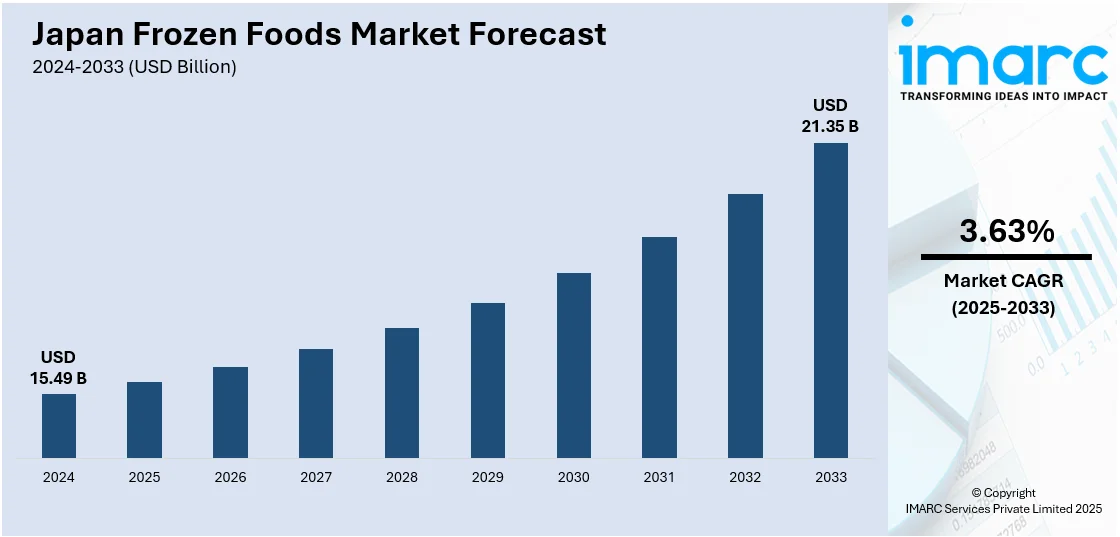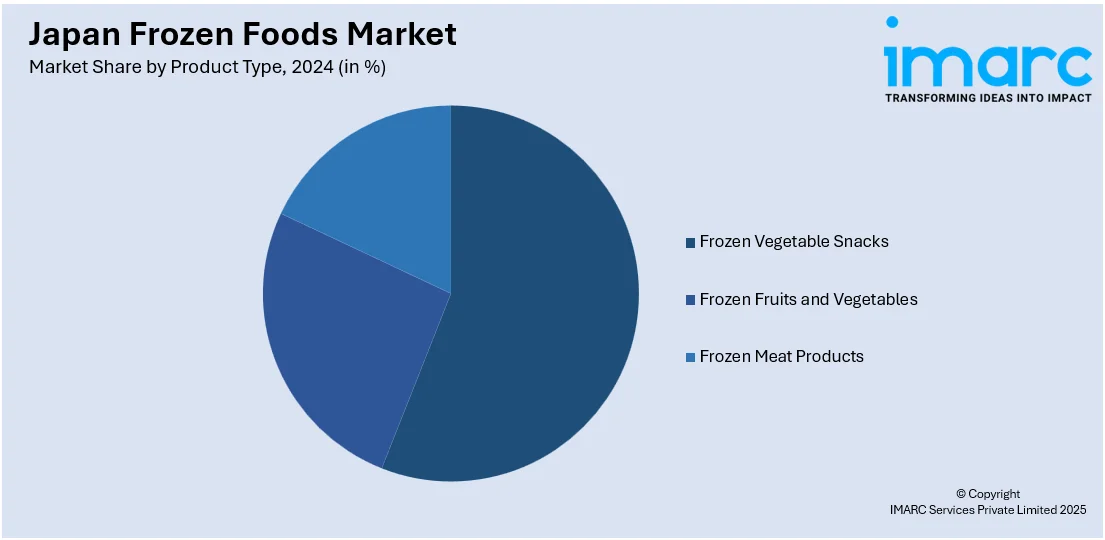
Japan Frozen Foods Market Size, Share, Trends and Forecast by Product Type and Region, 2025-2033
Japan Frozen Foods Market Overview:
The Japan frozen foods market size reached USD 15.49 Billion in 2024. Looking forward, IMARC Group expects the market to reach USD 21.35 Billion by 2033, exhibiting a growth rate (CAGR) of 3.63% during 2025-2033. The rising health awareness, demand for eco-friendly packaging, and a growing interest in international cuisine are driving the frozen foods market, as consumers seek nutritious, sustainable, and flavorful meal options that offer convenience, variety, and align with evolving dietary and lifestyle preferences.
|
Report Attribute
|
Key Statistics
|
|---|---|
|
Base Year
|
2024
|
|
Forecast Years
|
2025-2033
|
|
Historical Years
|
2019-2024
|
| Market Size in 2024 | USD 15.49 Billion |
| Market Forecast in 2033 | USD 21.35 Billion |
| Market Growth Rate 2025-2033 | 3.63% |
Japan Frozen Foods Market Trends:
Rising Demand for Functional and Nutritionally Balanced Meals
Health and wellness concerns are changing consumer preferences in Japan, leading to a rise in the demand for frozen foods that provide functional advantages beyond mere nutrition. As understanding about concerns such as protein shortage, metabolic wellness, and dietary requirements linked to aging increases, consumers are eagerly looking for meal choices that enhance nutrition while maintaining flavor and ease of preparation. Frozen food producers are reacting by creating items that include high protein levels, balanced macronutrients, and specific health benefits like reduced sodium or added vitamins. These products attract a wide array of people, ranging from active young adults to health-conscious elderly, seeking fast but meaningful meals. The blending of health benefits with ease and taste is broadening the impact of frozen foods in everyday meals, making them viable options for sustaining balanced, purpose-oriented dietary practices. In 2024, Nichirei Foods launched a new frozen food brand, "ON," under the "everyONe meal®" concept to address protein intake deficiencies. The brand focused on providing nutritious, protein-rich meals that were both delicious and convenient. This initiative aligned with Nichirei’s mission to combine health benefits and taste using freezing technology.

Focus on Sustainable Packaging and Environmental Responsibility
Sustainability is becoming a key factor in purchasing decisions in the frozen food sector, as eco-conscious consumers look for items that reflect their principles. Brands are adapting by reevaluating packaging design and moving towards compact, recyclable, and low-waste materials that minimize both household clutter and environmental effects. These advancements attract an increasing group of consumers who consider environmental impact when making purchases, especially in cities where recycling and waste sorting are rigorously implemented. Packaging that reduces plastic use, lessens storage size, and enhances logistics efficiency strongly appeals to households with constrained freezer space and those dedicated to eco-friendly living. The combined advantage of ease and environmental responsibility is positioning sustainable packaging as a crucial differentiator in a market where quality, efficiency, and ethics are increasingly intertwined. In 2024, Ajinomoto Frozen Foods launched the "Obento PON™" series, offering five bento-friendly frozen meals in compact, space-saving packaging. Designed to reduce freezer clutter and minimize plastic waste by 69%, these products catered to busy consumers looking for quick, eco-friendly meal solutions. The packaging also improved transportation efficiency, aligning with sustainability goals.
Growing Demand for International Flavors in Everyday Meals
In Japan, consumers are becoming more receptive to integrating international dishes into their everyday meals, catalyzing the demand for frozen foods that showcase global tastes. This change signifies evolving taste preferences shaped by travel, media exposure, and experiences with diverse cuisines. Frozen food producers are taking advantage of this trend by launching items influenced by Asian, Western, and fusion dishes and providing options without requiring dining out or intricate cooking. These internationally inspired frozen products enable consumers to discover new flavors while enjoying the ease of cooking at home. The frozen format guarantees uniform quality and flavor, providing a dependable cooking experience with little effort. With the increasing desire for new flavors and variety, frozen meals influenced by global cuisines are becoming a regular item in weekly grocery purchases. This trend expands the attraction of frozen foods while presenting them as vibrant, tasty substitutes for conventional Japanese home-cooked meals. In 2024, MUJI launched a new frozen food series featuring rice burgers in three international flavors: Bulgogi, Gapao, and Lu Rou Fan. Each pack contained two microwave-ready rice burgers, priced at 490 yen, combining rice buns with flavorful global toppings. The launch expanded MUJI’s popular frozen food line, offering quick and convenient rice-based meals.
Japan Frozen Foods Market Segmentation:
IMARC Group provides an analysis of the key trends in each segment of the market, along with forecasts at the regional level for 2025-2033. Our report has categorized the market based on product type.
Product Type Insights:

- Frozen Vegetable Snacks
- Frozen Fruits and Vegetables
- Frozen Meat Products
The report has provided a detailed breakup and analysis of the market based on the product type. This includes frozen vegetable snacks, frozen fruits and vegetable, and frozen meat products.
Regional Insights:
- Kanto Region
- Kansai/Kinki Region
- Central/ Chubu Region
- Kyushu-Okinawa Region
- Tohoku Region
- Chugoku Region
- Hokkaido Region
- Shikoku Region
The report has also provided a comprehensive analysis of all the major regional markets, which include Kanto Region, Kansai/Kinki Region, Central/ Chubu Region, Kyushu-Okinawa Region, Tohoku Region, Chugoku Region, Hokkaido Region, and Shikoku Region.
Competitive Landscape:
The market research report has also provided a comprehensive analysis of the competitive landscape. Competitive analysis such as market structure, key player positioning, top winning strategies, competitive dashboard, and company evaluation quadrant has been covered in the report. Also, detailed profiles of all major companies have been provided.
Japan Frozen Foods Market News:
- In April 2025, AEON launched three new frozen one-plate meals under its “TOPVALU BestPrice” brand, offering complete Japanese and Western-style dishes for just 321 yen each. These microwave-ready meals are available at 2,900 stores nationwide, catering to busy, price-conscious consumers.
- In March 2025, FOODEX JAPAN 2025, running from March 11–14 at Tokyo Big Sight, will spotlight the future of frozen food alongside global F&B trends. The expo features a wide range of frozen products, ranging from ready meals to health-focused options, and cutting-edge freezing technologies. A highlight is the “Frozen of Future” award, recognizing innovation in reducing food loss and enhancing quality in the frozen sector.
Japan Frozen Foods Market Report Coverage:
| Report Features | Details |
|---|---|
| Base Year of the Analysis | 2024 |
| Historical Period | 2019-2024 |
| Forecast Period | 2025-2033 |
| Units | Billion USD |
| Scope of the Report |
Exploration of Historical Trends and Market Outlook, Industry Catalysts and Challenges, Segment-Wise Historical and Future Market Assessment:
|
| Product Types Covered | Frozen Vegetable Snacks, Frozen Fruits and Vegetables, Frozen Meat Products |
| Regions Covered | Kanto Region, Kansai/Kinki Region, Central/ Chubu Region, Kyushu-Okinawa Region, Tohoku Region, Chugoku Region, Hokkaido Region, Shikoku Region |
| Customization Scope | 10% Free Customization |
| Post-Sale Analyst Support | 10-12 Weeks |
| Delivery Format | PDF and Excel through Email (We can also provide the editable version of the report in PPT/Word format on special request) |
Key Questions Answered in This Report:
- How has the Japan frozen foods market performed so far and how will it perform in the coming years?
- What is the breakup of the Japan frozen foods market on the basis of product type?
- What is the breakup of the Japan frozen foods market on the basis of region?
- What are the various stages in the value chain of the Japan frozen foods market?
- What are the key driving factors and challenges in the Japan frozen foods market?
- What is the structure of the Japan frozen foods market and who are the key players?
- What is the degree of competition in the Japan frozen foods market?
Key Benefits for Stakeholders:
- IMARC’s industry report offers a comprehensive quantitative analysis of various market segments, historical and current market trends, market forecasts, and dynamics of the Japan frozen foods market from 2019-2033.
- The research report provides the latest information on the market drivers, challenges, and opportunities in the Japan frozen foods market.
- Porter's five forces analysis assist stakeholders in assessing the impact of new entrants, competitive rivalry, supplier power, buyer power, and the threat of substitution. It helps stakeholders to analyze the level of competition within the Japan frozen foods industry and its attractiveness.
- Competitive landscape allows stakeholders to understand their competitive environment and provides an insight into the current positions of key players in the market.
Need more help?
- Speak to our experienced analysts for insights on the current market scenarios.
- Include additional segments and countries to customize the report as per your requirement.
- Gain an unparalleled competitive advantage in your domain by understanding how to utilize the report and positively impacting your operations and revenue.
- For further assistance, please connect with our analysts.
 Request Customization
Request Customization
 Speak to an Analyst
Speak to an Analyst
 Request Brochure
Request Brochure
 Inquire Before Buying
Inquire Before Buying




.webp)




.webp)












